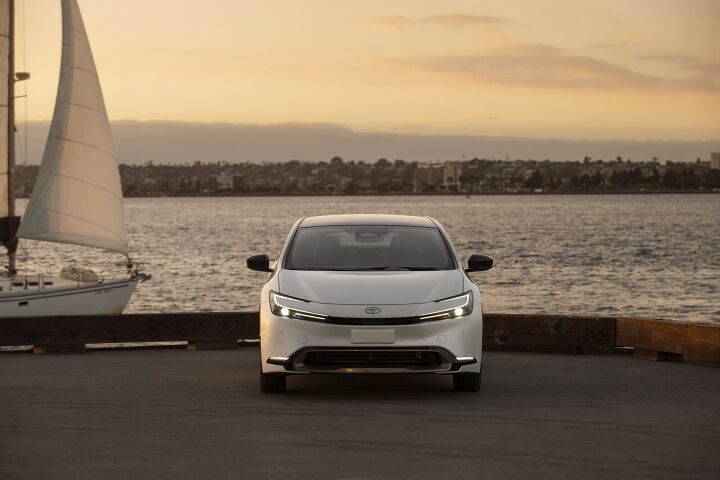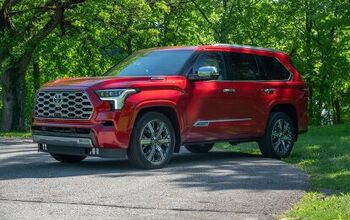2023 Toyota Prius Review – Better, But is That Good Enough?

The Toyota Prius has pretty much always been focused solely on fuel economy. The design was driven by the desire to maximize MPGs. Driving dynamics took a back seat to fuel economy. If you bought a Prius (or leased one) you likely bought it for fuel economy – or maybe because it was affordable.
The redesigned 2023 Toyota Prius is supposed to change all that without sacrificing all that fuel-economy stuff.
Does it? Well, for the most part, yes. But is that good enough to lure in those who have long disdained the car as a wedge-shaped penalty box that existed only to lengthen the time between fill-ups?
Toyota bumps the power by giving the hybrid a larger gas engine – it’s now 2.0-liters instead of 1.8, and horsepower is now up to 196 on all-wheel-drive models and 194 on front-wheel-drive models. Toyota claims this brings 0-60 times up to 7 seconds for FWD cars and 7.2 AWD cars – slow, sure, but far more respectable than the 10-second times from before.
Torque is at 139 lb-ft and that gets to the ground via a continuously-variable automatic transmission. The battery is lithium-ion.
Toyota invited Chicago-area media to the city’s far western suburbs to drive the Prius, along with the Crown, last week.
(Full disclosure: Toyota fed us and offered us a travel coffee mug, which I did not take. I did take a notebook and pen).
The Prius’s new duds make the car more attractive but it remains wedge-shaped. Style-wise, it strikes a nice balance between looking decent and having the aerodynamics needed for fuel economy of up to 57 mpg. It’s still far from sexy, but it no longer looks like a rolling roadblock. The old car could be tough on the eyes – this one at least will blend.
On road, the car doesn’t really feel anywhere in the neighborhood of swift, but it finally gets out of its own way. Suburban driving won’t be a chore, and while there’s still not a lot of grunt, passing and merging will be a slightly easier proposition. You may still have to plan ahead, but you won’t need the same level of strategy that is usually reserved for an F1 pit box.
The most joyously pleasant surprise here is the handling. It’s still not great, nor do I expect it to be, but there’s just enough going on here to remind you that you are, in fact, driving a car. The old Prius could feel as disconnected as a spouse in a crumbling marriage. This one, at least, gives a hint that there are tires and wheels at the front of the car and they are doing things. You can feel it, though the steering remains artificial.
Turn-in is fairly sharp and body roll isn’t too noticeable. We’re still a long way from fun-to-drive, but the new Prius is at least as engaging as any other small commuter car on the market. The old days of being punished in terms of driving dynamics because you want to save on fuel are over. Corners are no longer cause for dread.
There is a Sport mode, and you can feel the steering tighten up a bit when it’s engaged.
The new Prius has driving dynamics that are much improved – so much so that it’s no longer a chore to drive. It’s not a joy, either, but that’s OK – it’s not meant to be. Given current technology and the laws of physics/aerodynamics, Toyota has engineered a pretty good trade-off here. The car remains a fuel sipper but it’s loosened up a bit and can be occasionally amusing.
The ride is a little on the stiff side but generally acceptable. I did notice a bit too much outside noise creeping in with the radio off, but blasting the stereo will probably mitigate that.
The interior remains a bit spartan and downmarket in feel, but there are buttons where there should be buttons, and the digital gauges and the newest version of Toyota infotainment are appreciated.
Toyota is offering the Prius in three trims – LE, XLE, and Limited. The base LE starts at $27,450. The front-drive XLE I piloted will set you back $32,905 -- $34,000 on the dot with destination.
Standard or available features include 17-inch wheels, USB ports, blind-spot monitoring, front and rear parking assist, heated driver’s seat, 19-inch wheels, 12.3-inch infotainment screen, fixed glass roof, rain-sensing wipers, wireless cell-phone charger, digital key, JBL audio, heated and cooled front seats, heated rear seats, heated steering wheel, digital rearview mirror, Bluetooth, wireless Apple CarPlay and Android Auto, satellite radio, and Toyota’s Safety Sense 3.0 suite of advanced driver-assistance systems (includes lane-departure alert with steering assist, pre-collision system with pedestrian detection, and smart cruise control).
Fuel economy is listed as follows: 57/56/57 for the base LE, 52/52/52 for the XLE and Limited FWD, 53/54/54 for the LE AWD, and 49/50/49 for the XLE and Limited with AWD.
The newest Prius is much improved in terms of driving dynamics and exterior design, and it’s still a fuel-sipper. It’s a much more well-rounded vehicle, and that makes it a better car than what came before. The question is if that will be enough to bring over some buyers who previously dismissed the Prius as a punishment machine aimed at the most eco-friendly among us.
I suspect the answer will be yes for those who merely commute – this car will work just fine for getting you from point A to B, especially now that its biggest dynamic flaws are eliminated. Those who want a bit more pizazz, however, can probably find a fuel-sipping hybrid or even an ICE vehicle elsewhere.
[Images: Toyota]
Become a TTAC insider. Get the latest news, features, TTAC takes, and everything else that gets to the truth about cars first by subscribing to our newsletter.

Tim Healey grew up around the auto-parts business and has always had a love for cars — his parents joke his first word was “‘Vette”. Despite this, he wanted to pursue a career in sports writing but he ended up falling semi-accidentally into the automotive-journalism industry, first at Consumer Guide Automotive and later at Web2Carz.com. He also worked as an industry analyst at Mintel Group and freelanced for About.com, CarFax, Vehix.com, High Gear Media, Torque News, FutureCar.com, Cars.com, among others, and of course Vertical Scope sites such as AutoGuide.com, Off-Road.com, and HybridCars.com. He’s an urbanite and as such, doesn’t need a daily driver, but if he had one, it would be compact, sporty, and have a manual transmission.
More by Tim Healey
Latest Car Reviews
Read moreLatest Product Reviews
Read moreRecent Comments
- Bd2 Lexus is just a higher trim package Toyota. ^^
- Tassos ONLY consider CIvics or Corollas, in their segment. NO DAMNED Hyundais, Kias, Nissans or esp Mitsus. Not even a Pretend-BMW Mazda. They may look cute but they SUCK.I always recommend Corollas to friends of mine who are not auto enthusiasts, even tho I never owed one, and owned a Civic Hatch 5 speed 1992 for 25 years. MANY follow my advice and are VERY happy. ALmost all are women.friends who believe they are auto enthusiasts would not listen to me anyway, and would never buy a Toyota. They are damned fools, on both counts.
- Tassos since Oct 2016 I drive a 2007 E320 Bluetec and since April 2017 also a 2008 E320 Bluetec.Now I am in my summer palace deep in the Eurozone until end October and drive the 2008.Changing the considerable oils (10 quarts synthetic) twice cost me 80 and 70 euros. Same changes in the US on the 2007 cost me $219 at the dealers and $120 at Firestone.Changing the air filter cost 30 Euros, with labor, and there are two such filters (engine and cabin), and changing the fuel filter only 50 euros, while in the US they asked for... $400. You can safely bet I declined and told them what to do with their gold-plated filter. And when I changed it in Europe, I looked at the old one and it was clean as a whistle.A set of Continentals tires, installed etc, 300 EurosI can't remember anything else for the 2008. For the 2007, a brand new set of manual rec'd tires at Discount Tire with free rotations for life used up the $500 allowance the dealer gave me when I bought it (tires only had 5000 miles left on them then)So, as you can see, I spent less than even if I owned a Lexus instead, and probably less than all these poor devils here that brag about their alleged low cost Datsun-Mitsus and Hyundai-Kias.And that's THETRUTHABOUTCARS. My Cars,
- NJRide These are the Q1 Luxury division salesAudi 44,226Acura 30,373BMW 84,475Genesis 14,777Mercedes 66,000Lexus 78,471Infiniti 13,904Volvo 30,000*Tesla (maybe not luxury but relevant): 125,000?Lincoln 24,894Cadillac 35,451So Cadillac is now stuck as a second-tier player with names like Volvo. Even German 3rd wheel Audi is outselling them. Where to gain sales?Surprisingly a decline of Tesla could boost Cadillac EVs. Tesla sort of is now in the old Buick-Mercury upper middle of the market. If lets say the market stays the same, but another 15-20% leave Tesla I could see some going for a Caddy EV or hybrid, but is the division ready to meet them?In terms of the mainstream luxury brands, Lexus is probably a better benchmark than BMW. Lexus is basically doing a modern interpretation of what Cadillac/upscale Olds/Buick used to completely dominate. But Lexus' only downfall is the lack of emotion, something Cadillac at least used to be good at. The Escalade still has far more styling and brand ID than most of Lexus. So match Lexus' quality but out-do them on comfort and styling. Yes a lot of Lexus buyers may be Toyota or import loyal but there are a lot who are former GM buyers who would "come home" for a better product.In fact, that by and large is the Big 3's problem. In the 80s and 90s they would try to win back "import intenders" and this at least slowed the market share erosion. I feel like around 2000 they gave this up and resorted to a ton of gimmicks before the bankruptcies. So they have dropped from 66% to 37% of the market in a quarter century. Sure they have scaled down their presence and for the last 14 years preserved profit. But in the largest, most prosperous market in the world they are not leading. I mean who would think the Koreans could take almost 10% of the market? But they did because they built and structured products people wanted. (I also think the excess reliance on overseas assembly by the Big 3 hurts them vs more import brands building in US). But the domestics should really be at 60% of their home market and the fact that they are not speaks volumes. Cadillac should not be losing 2-1 to Lexus and BMW.
- Tassos Not my favorite Eldorados. Too much cowbell (fins), the gauges look poor for such an expensive car, the interior has too many shiny bits but does not scream "flagship luxury", and the white on red leather or whatever is rather loud for this car, while it might work in a Corvette. But do not despair, a couple more years and the exterior designs (at least) will sober up, the cowbells will be more discreet and the long, low and wide 60s designs are not far away. If only the interiors would be fit for the price point, and especially a few acres of real wood that also looked real.







































Comments
Join the conversation
I’m not sure when it became the norm to snub cars that do zero to sixty in seven seconds. What is the great hurry? You in a rush to see another teen totaling daddy’s car?
The Prius outsells all GM EVs combined, which is really not saying much.